Meet the cat family
|
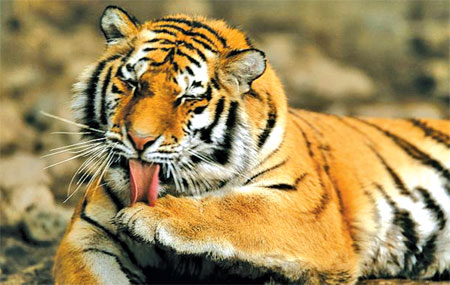
Tiger |
Felidae is the biological family of the cats; a member of this family
is called a felid. Felids are the strictest carnivores of the 13
terrestrial families in the order Carnivora, although the three families
of marine mammals comprising the super family pinnipedia, they are as
carnivorous as the felids. The most familiar felid is the domestic cat,
which first became associated with humans about 10,000 years ago, but
the family includes all other wild cats including the big cats. Felids
belong to one of two subfamilies: Pantherinae (which includes the tiger,
the lion, the jaguar, and the leopard), and Felinae (which includes the
cougar, the cheetah, the lynxes, the ocelot, and the domestic cat).
The first felids emerged during the Oligocene, about 25 million years
ago. In prehistoric times, there was a third subfamily known as
Machairodontinae, which included the "saber-toothed cats" such as the
well - known Smilodon. There were also other superficially cat-like
mammals, such as the marsupial sabertooth Thylacosmilus or the
Nimravidae, which are not included in Felidae despite superficial
similarities.
Cats whether big or small or very interesting animals .There are a
number of species whch belong to this family and today we feature some
interesting facts about a few of them....
[Tigers]
* Tigers are the biggest species of the cat family.
* Tigers can reach a length of up to 3.3 metres (11 feet) and weigh
as much as 300 kilograms (660 pounds).
* Subspecies of the tiger include the Sumatran Tiger, Siberian Tiger,
Bengal Tiger, South China Tiger, Malayan Tiger and Indochinese Tiger.
* Many subspecies of the tiger are either endangered or already
extinct. Humans are the primary cause of this through hunting and the
destruction of habitats.
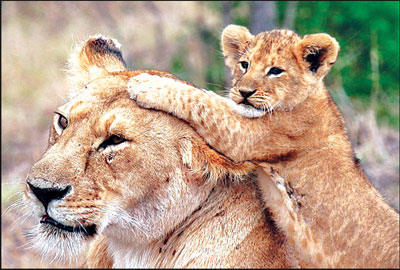
Lions |
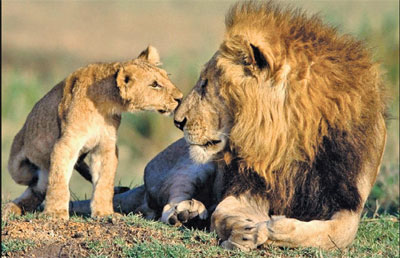 |
* Around half of tiger cubs don't live beyond two years of age.
* Tiger cubs leave their mother when they are around two years of
age.
* A group of tigers is known as an 'ambush' or 'streak'.
* Tigers are good swimmers and can swim up to six kilometres.
* Rare white tigers carry a gene that is only present in around 1 in
every 10000 tigers.
* Tigers usually hunt alone at night time.
* Tigers have been known to reach speeds up to 65 kph (40 mph).
* Less than 10 per cent of hunts end successfully for tigers.
* Tigers can easily jump over five metres in length.
[Lions]
* Lions are the second largest big cat species in the world (behind
tigers).
* The average male lion weighs around 180 kg (400 lb) while the
average female lion weighs around 130 kg (290 lb).
* The heaviest lion on record weighed an amazing 375 kg (826 lb).
* Lions can reach speeds of up to 81 kph (50 mph) but only in short
bursts because of a lack of stamina.
* The roar of a lion can be heard from 8 kilometres (5.0 miles) away.
* Most lions found in the wild live in southern and eastern parts of
Africa.
* Lions are very social compared to other cat species, often living
in prides that feature females, offspring and a few adult males.
* Male lions are easy to recognise thanks to their distinctive manes.
Males with darker manes are more likely to attract female lions
(lionesses).
| |
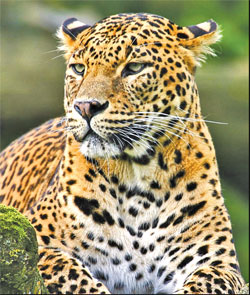
Leopard |

Cheetah |
* Lions are the national animal of Albania, Belgium, Bulgaria,
England, Ethiopia, Luxembourg, the Netherlands and Singapore.
* Lions in the wild live for around 12 years.
* When lions breed with tigers the resulting hybrids are known as
ligers and tigons. There are also lion and leopard hybrids known as
leopons and lion and jaguar hybrids known as jaglions.
* Lionesses are better hunters than males and do most of the hunting
for a pride.
* In the wild, lions rest for around 20 hours a day.
[Leopards]
* Leopards are part of the cat family, Felidae and the scientific
name for a leopard is Panthera pardus.
* Leopards are well known for their cream and gold spotted fur, but
some leopards have black fur with dark spots. These black leopards are
often mistaken for panthers.
* Adult leopards are solitary animals. Each adult leopard has its own
territory where it lives and, although they often share parts of it,
they try to avoid one another.
* A leopard's body is built for hunting. They have sleek, powerful
bodies and can run at speeds of up to 57 kilometres per hour. They are
also excellent swimmers and climbers and can leap and jump long
distances.
* A leopard's tail is just about as long as its entire body. This
helps it with balance and enables it to make sharp turns quickly.
* Leopards are mostly nocturnal, hunting prey at night.
* Leopards protect their food from other animals by dragging it high
up into the trees. A leopard will
often leave its prey up in the tree for days and return only when
it is hungry!
* Female leopards give birth to a litter of two or three cubs at a
time. By the time a cub is two years old it will leave the company of
its mother and live on its own.
* Some people believe that the bones and whiskers of leopards can
heal sick people. Many leopards are killed each year for their fur and
body parts and this is one reason why the leopard is an endangered
animal. While they were previously found in the wild in a number of
areas around the world, their habitat is largely restricted to
sub-Saharan Africa with small numbers also found in India, Pakistan,
Malaysia, China and Indochina.
[Jaguars]
* Male jaguars weigh 125-250 lb while females weigh 100-200lb. The
average body lenght is 44-73 in.Tail is 118-30 in.
* They are found in Central and SouthAmerica as far as Patagonia.
* Adults are solitary.A young jaguar stays with the mother for a few
years before finding itsown territory. The size of the jaguar's
territory depends on the availabilityof food.
* The female gives birth to 1-4 young.
* Ground-living animals,domestic stock, fish, frogs, turtles, and
small alligators comprise their diet .
* Jaguars hunt mainly at night on the ground.They can cover short
distances rapidly.
* All subspecies are endangered. Many are extinct except in zoos.
Main concern is over hunting and loss of habitat.
* They can live up to 22 years.
* All-black jaguars are pretty common.
* The jaguars are smaller and stalkier than their cousins (the
leopard), but they are more powerful.
* They are excellent swimmers and prefer areas with plenty of fresh
water.
[Cheetahs]
* A cheetah can accelerate from 0 to 113 km in just a few seconds.
* Cheetahs are extremely fast. However, they tire quickly and can
only keep up their top speed for a few minutes before they are too tired
to continue.
* Cheetahs are smaller than other members of the big cat family,
weighing only 45 - 60 kilograms.
* One way to always recognise a cheetah is by the long, black lines
which run from the inside of each eye to the mouth. These are usually
called "tear lines" and scientists believe they help protect the
cheetah's eyes from the harsh sun and help them to see long distances.
* Cheetahs are the only big cat that cannot roar. The can purr though
and usually purr most loudly when they are grooming or sitting near
other cheetahs.
*While lions and leopards usually do their hunting at night, cheetahs
hunt for food during the day.
* A cheetah has amazing eyesight during the day and can spot prey
from 5 km away.
* Cheetahs cannot climb trees and have poor night vision.
*With their light body weight and blunt claws, cheetahs are not well
designed to protect themselves or their prey. When a larger or more
aggressive animal approaches a cheetah in the wild, it will give up its
catch to avoid a fight.
* Cheetahs only need to drink once every three to four days.
[General facts]
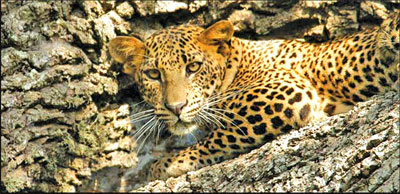 |
|
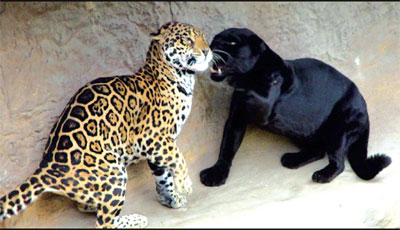
aguars |
* The felids' closest relatives are thought to be the linsangs.
* All felid species share a genetic anomaly that prevents them from
tasting sweetness.
* There are 41 known species of felids in the world today, which have
all descended from the same ancestor.
* All felids share a broadly similar set of vocalisations, although
there is some variation between species
* All felids are able to spit, hiss, growl, snarl, and mew.
* Most felids seem to be able to purr, vibrating the muscles in their
larynx to produce a distinctive buzzing sound. In the wild, purring is
used while a mother is caring for kittens.
*Felids have a relatively small number of teeth compared with other
carnivorans, a feature associated with their short muzzles.
* Felids tend to have lithe and flexible bodies with muscular limbs.
Facts and pix: Internet |

